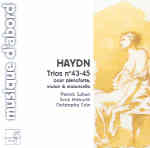These are good performances of Haydn’s late trios, three of his finest works in the medium, that will appeal to you more if you prefer an overtly expressive approach. What this means in practical terms is that especially in the quick movements, the players indulge in all sorts of gear-shifting and underlining, and sometimes this can verge on mannerism. In the Trio No. 44 (28) in E major, for example, the finale doesn’t take off quite as it should, despite a really excellent account of the marvelous preceding slow movement–that wonderful passacaglia, with its mixture of proto-Romantic passion and Baroque austerity.
Similarly, the German dance finale of Trio No. 45 (29) in E-flat needs less fiddling and more emphasis on its sheer rhythmic gusto than these players allow. That said, the playing as such is often quite beautiful, and Patrick Cohen’s clean but small-toned fortepiano aptly justifies Haydn’s rationale in having the cello double the bass line, while the violin sometimes follows the treble and more often sings above it. If you must have period instruments in this repertoire, I still prefer the more lively and straightforward Levin/Beths/Bylsma renditions on Sony Vivarte, if you can still find that disc–but there’s no disparaging the basic musicality and intelligence that typifies these performances.
































